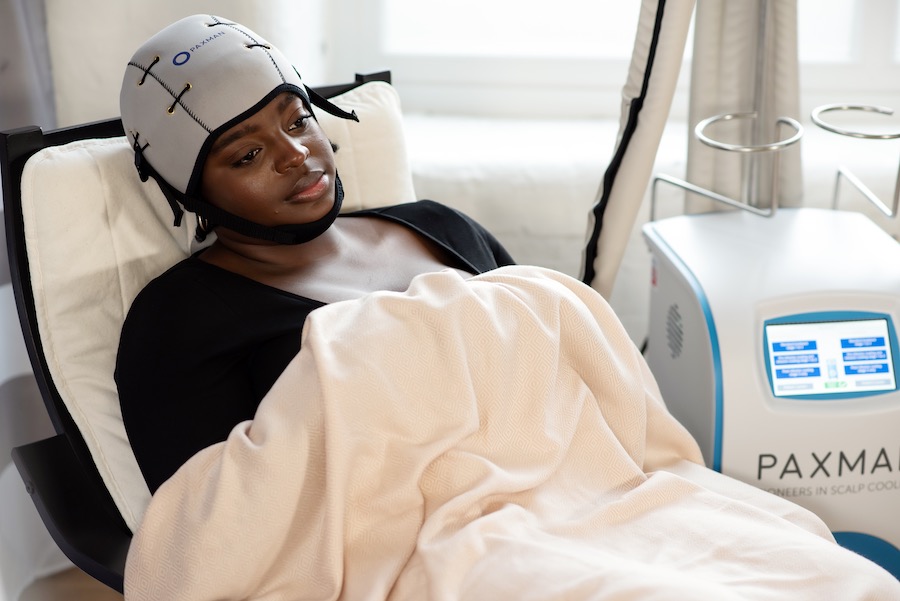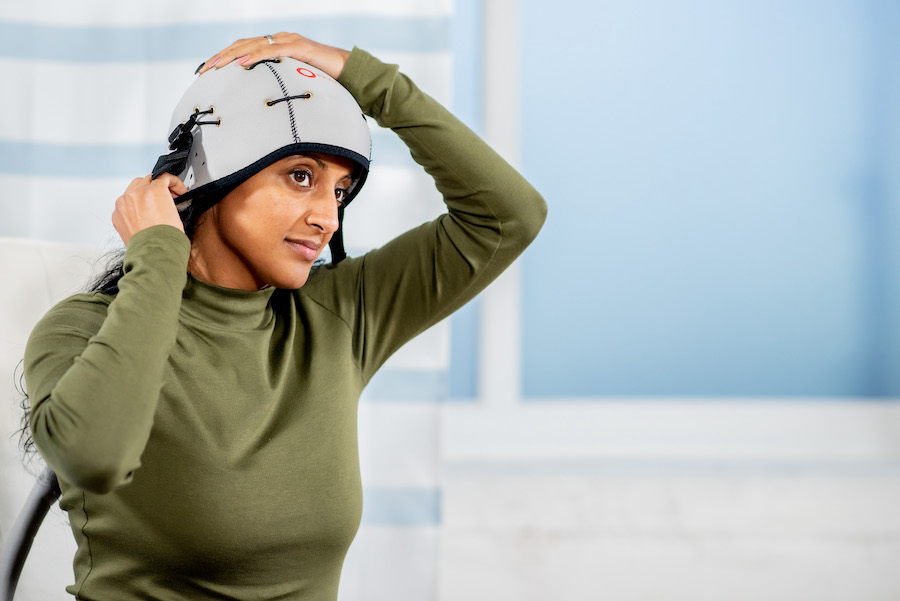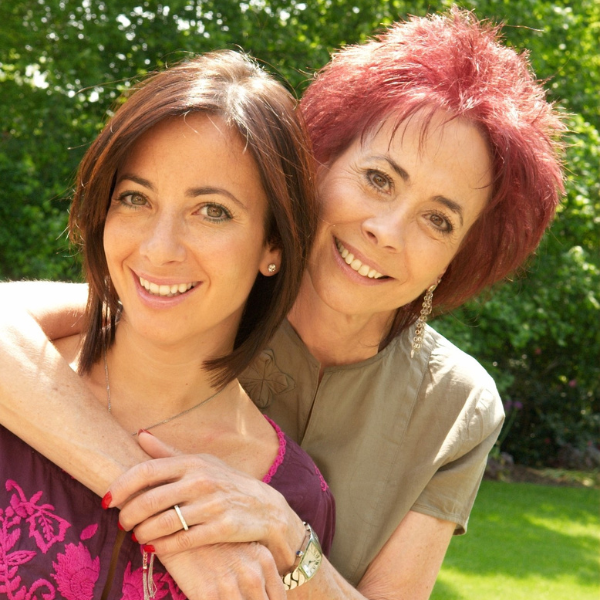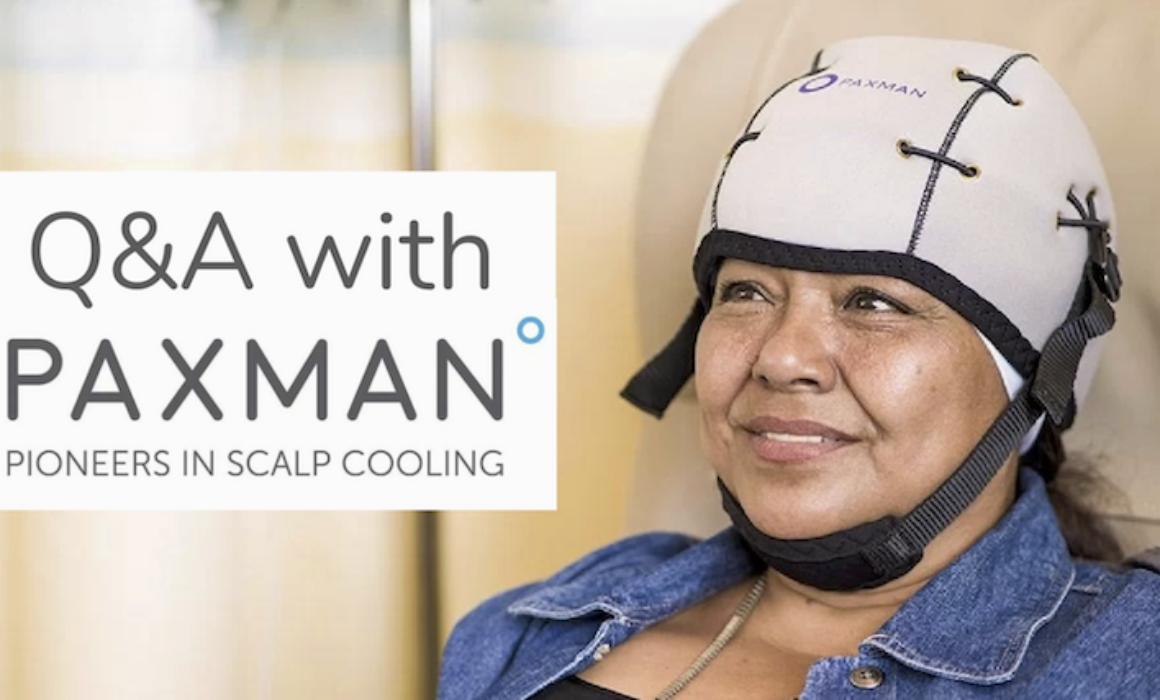
Scalp cooling technology can help chemotherapy patients to minimise or prevent hair loss. In this article, Claire Paxman of Paxman Scalp Cooling has answered the frequently asked questions that people have about using a scalp cooling system during their treatment.
By Claire Paxman
1. CAN YOU TELL US A BIT ABOUT SCALP COOLING – WHAT IS IT AND HOW DOES IT WORK?
Of course, when faced with a cancer diagnosis there is a pantheon of challenges and questions that engulf you, and on that long horrendous list, from the outside at least, hair may just not seem that important. But we know that hair loss is constantly cited as one of the top three greatest concerns for people facing chemotherapy, so much so that an estimated 12% of people refuse chemotherapy treatment outright due to the fear of losing their hair. Scalp cooling is the only clinically proven method to manage hair loss during chemotherapy through both hair retention and then later, faster hair regrowth for patients going through cancer treatment. What is Scalp Cooling.
Chemotherapy works by targeting all rapidly dividing cells, and hair cells are the second-fastest-dividing cells in the body – the reason why many chemotherapy drugs cause hair loss. Vulnerable hair follicles in the growth phase are attacked, resulting in rapid and extensive hair loss approximately two weeks after the start of chemotherapy.
Scalp Cooling technology can alleviate the damage caused to the hair follicles by chemotherapy by reducing the temperature of the scalp by a few degrees before, during, and after chemotherapy treatment.
This cooling process is usually undertaken using a machine-based cooling system such as the Paxman Scalp Cooling System, a compact refrigeration unit, which circulates liquid coolant at low pressure through a special cooling cap worn by the patient. The circulation of the refrigerated coolant through the cap extracts heat from the patient’s scalp maintaining the optimum temperature for hair preservation.
2. WHAT TEMPERATURE DOES SCALP COOLING COOL MY HEAD DOWN TO?
It is common to hear people talking about cold caps freezing their follicles, but this is a myth! Scalp cooling absolutely does not freeze your scalp! The optimum scalp cooling temperature for hair retention is between 18 and 22 degrees Celsius – significantly above zero! The coolant in the system operates at a temperature between -4 & -1 degrees Celsius, reducing the scalp temperature to this optimum level. Sometimes, once the cap is removed post treatment you may see ice on the hair from the water and conditioner that is used to prepare the hair before the cap is fitted.
3. IF I USE SCALP COOLING WILL I DEFINITELY KEEP MY HAIR?
No two people will have the same reaction to a drug or any set of circumstances, and scalp cooling is no different. We know a lot about why scalp cooling works, but what we do not always know is why scalp cooling doesn’t work for some people. It is important to have realistic expectations and you may find the Paxman Scalp Cooling Facebook Group a good place to start.
It is important to know that you will lose some hair. Even if scalp cooling works really well, everyone will shed hair at some level during treatment, it can vary from hardly any hair to significant hair loss depending on several factors. Hair shedding will usually begin on days 14-21 after the first chemotherapy treatment and this is the case whether you choose to cold cap or not. Even if you do lose some hair, it doesn’t mean that the cold cap isn’t working – without it you would likely lose most, if not all, of your hair.
The success rate for Scalp Cooling is up to 70% for some chemotherapy regimens. It is lower for other regimens, but there is evidence that scalp cooling encourages faster, healthier and stronger hair regrowth than would occur without scalp cooling. There is a handy outcomes calculator that gives you an indication of the amount of hair retention you could expect, based on the chemotherapy regimen you will be receiving. If you know your dosage you will get a more accurate indication.

4. IS SCALP COOLING SUITABLE FOR ALL HAIRSTYLES? THICK, THIN, STRAIGHT, CURLY, HIGHLIGHTED, AFRO, LONG, SHORT, PERMED?
Anyone can cold cap – women and men, and whatever kind of hair – there is no evidence to show that scalp cooling is more or less effective for different genders, ethnicities or with different hair types. Understanding your hair type can however really help you to know how to best care for it during scalp cooling. Your hairstyle has no impact on whether or not you can scalp cool. There is lots of advice to be found on this topic on our website.
5. CAN I USE SCALP COOLING WITH LONG HAIR, OR DO I NEED TO HAVE MY HAIR CUT INTO A SHORT STYLE?
This is another myth that does the rounds. There is absolutely no requirement to cut your hair before you start scalp cooling. The only time that cutting the hair before scalp cooling maybe helpful is if you have very long thick hair – but only to alleviate some of the weight at the scalp. Your hair will be much easier to look after if it is in good condition, so a good trim to get rid of split ends and dry, damaged hair is a good idea to make the hair more manageable. Hair care during cold capping is important – the more manageable the better, particularly as it is easy for long or over-processed hair to become tangled. There are many helpful resources available here, on our website.
6. DO ALL HOSPITALS IN THE UK OFFER SCALP COOLING? AND IF NOT AT MY HOSPITAL, IS THERE ANY WAY I CAN ACCESS IT FOR MY CHEMO SESSIONS?
99% of NHS and private hospitals in the UK have Paxman scalp cooling systems. If you think you are eligible for scalp cooling always ask – unfortunately it is not always offered. If you are unsure if your hospital offers scalp cooling, you can check here. Scalp Cooling is also available if you are having chemotherapy at home via Sciensus or Lloyds Pharmacy Clinical Homecare as long as you have Private Medical Insurance.

7. HOW DO I PREPARE MY HAIR FOR MY CHEMO SESSION IF I AM SCALP COOLING?
There are some key differences in how to prepare your hair for scalp cooling depending on your hair type. Understanding your hair type will help you prepare your hair in the best way for you so have a look at the ‘how-to’ videos on this page on our website. Hair is dampened to reduce volume and to improve contact with the cap for optimum heat extraction from the scalp.
If you have type 1 or type 2 hair use a spray bottle to dampen your hair. There is no specific quantity of water used, just enough to be able to slick the hair back. A small amount of conditioner should then be smoothed over the hair surface. For long hair – it is only the hair under the cap that needs dampening, there is no need to dampen the lengths.
For those with type 3 and 4 hair you need to really wet the hair. Curly hair is generally a lot more porous and therefore will need a lot more water making the spray bottle a more difficult way of wetting the hair. You may choose to run your hair under a tap or shower so that it is wet enough to reduce the hair volume and allow a good cap fit. Conditioner should again then be smoothed over the hair surface. The lengths of your hair don’t need to be wet if they are not under the cap, the ends can be dried off with a towel once the cap is fitted.
The ‘how-to’ videos guide you through the process to ensure the best possible scalp cooling outcomes.
8. WHAT CAN I EXPECT DURING CHEMO WHEN I AM SCALP COOLING?
Get to know the scalp cooling process before your first treatment day. There is a wealth of information on www.coldcap.com or in the Paxman Scalp Cooling patient brochures that will help you to feel as prepared as possible. Make sure that you take along some warm clothes and maybe a blanket or scarf to help you keep cosy while you are using the cold cap, and a hat or a hoody to wear on your way home, as your hair will be wet.
The first 15 minutes can be tough as the cold can be very intense, but your body will acclimatise. The large majority of people find that they soon feel numb rather than very cold and that scalp cooling is completely manageable. Distractions can really help during the first 15 minutes, and making sure that your forehead is protected from direct contact with the cap can make the cap much more bearable. Check out our website page on preparing for your treatment day.
Claire Paxman’s top tips will help scalp cooling be as manageable as possible:
Shedding is normal and doesn’t mean Scalp cooling isn’t working
Shedding for many people is the most dreaded part of scalp cooling. Hair loss can be distressing, messy, and tiresome and for many it strikes fear into their hearts that scalp cool isn’t working. Shedding is a normal part of scalp cooling too. It begins for everyone between days 14 and 21 after your first treatment. This does not mean that scalp cooling has failed. Don’t be disheartened and try to concentrate on the hair that remains and not the hair you have lost.
Brush your hair!
People are often terrified to brush their hair, and there has been some advice around in the past that you should avoid brushing your hair during cold capping, but exactly the opposite is true. We would recommend brushing your hair every day, ideally once in the morning and once in the evening, and definitely before washing your hair. Liberating the loose hairs is imperative to prevent tangling and knotting, which can easily lead to matting (which you really, really don’t want).
Wash your hair regularly
No more than twice a week, but probably no less than once every 10 days. Wash day can strike fear in to people using scalp cooling, as washing your hair will really release those shed hairs, leaving a shower drain that is hard to look at, but this is exactly why it’s so important. Washing your hair won’t pull it out, just as brushing, but it reveals and liberates the already loose shed hair. For all hair care advice, please visit our helpful hair care blog www.coldcaphaircare.com

9. DO YOU HAVE ANY TIPS TO HELP ME FIT THE COLD CAP PROPERLY ON MY HEAD?
A good cap fit is crucial to achieving the best possible scalp cooling outcome. Ensuring that your cap provides a consistent all-over fit is the most important thing you can do for the best possible hair retention. We have some great ’how-to’ videos and for top tips, advice and helpful videos follow Claire Paxman on Instagram @claire.paxman
In the UK usually the nurses or clinical staff on the chemo ward do cap fitting, but in the US the patient has their own cap and often takes responsibility for the fitting. You are your own best advocate, never be afraid to speak up if you are unhappy with the way your cap has been fitted.
The most important thing to be aware of is that the cap is fitted centrally and evenly. The cap must be in contact with your crown (no bulges or bubbles that may mean the silicone cap is not in contact with any part of your scalp). It is important that the cap covers the hairline at the front but only by a couple of millimetres below, therefore not covering the forehead, (this is where the headband can come in useful to protect your forehead). The cap shouldn’t gape at the back of your head and once the neoprene cover is on top of the silicone cap, pull the bungee cords tight.
10. HOW LONG DOES SCALP COOLING TAKE?
Scalp cooling will add extra time on to treatment day. Everyone needs a 30-minute pre-infusion cooling time or 45 minutes if you have very thick type 3 or 4 hair. This pre-infusion cooling time ensures that your scalp reaches 18-22 degrees before the chemo drugs are infused into your system. This can often be done while other pre-med drugs are being administered, or you are being prepped for the chemo. The cooling continues throughout the infusion time of the chemo drugs, then there is an additional post-infusion cooling time which is dependent on the drugs you are receiving – for docetaxel it is 20 minutes, weekly paclitaxel is 60 minutes and all other regimens are 90 minutes.
11. IT SOUNDS PAINFUL, DO YOU HAVE ANY TIPS TO HELP WITH POSSIBLE HEADACHES DURING SCALP COOLING TREATMENT?
Everyone’s tolerance to the cold is different, but scalp cooling should in no way be painful! People tend to report that the first 10-15 minutes are the most uncomfortable. This is due to the scalp being rapidly reduced in temperature from 37°C to somewhere between 18°C and 22°C. It is worth taking some pain relief in advance to take the edge off. Something that works as a distraction is also a good idea, whether it is, meditation, a book or magazine, music, a film or series on your phone or tablet (don’t forget the headphones), or a friend or family member to chat to you. It will help make those first 10- 15 minutes, which can be tough, a little easier. Also, don’t forget to protect that forehead! This really does help with any discomfort and ensures that the inner cold cap is not in direct contact with the skin.

12. BETWEEN CHEMO AND SCALP COOLING SESSIONS, CAN I WASH, DRY AND STYLE MY HAIR AS USUAL, USING MY REGULAR HAIR PRODUCTS? OR DO I NEED TO DO ANYTHING DIFFERENTLY?
Hair care is really important throughout the treatment process, from the first chemo sessions all the way through to a couple of months after your final one. Many people understandably become very anxious about even touching their hair, but it is really important to maintain daily hair care. Keeping your hair manageable is the key. Washing and brushing are often associated with hair shedding. These processes have no effect what so ever on whether your hair will shed – they just make the hair that has already shed more apparent.
We would recommend washing your hair no more than a couple of times a week in lukewarm water – but it is important that you rinse out the conditioner from the day of your treatment within 24 hours. It seems counter intuitive but leaving the conditioner in can make your hair less easy to manage. Try to use colour-, perfume- and sulphate-free products as your scalp and skin can be very sensitive during chemo. When you are washing your hair don’t ever pile it on the top of your head and rub – that’s a one way ticket to some serious knotting. Just smooth the shampoo or conditioner down through the lengths of your hair.
Brush your hair EVERY DAY with a detangling brush. This is one that people are often petrified of, but it is so important to remove any strands that are being shed, because it is so easy for those strands to get tangled up in your hair and become clumps or matts that are near impossible to brush out. Start by brushing from the ends of the hair and then slowly move up the hair, holding the hair below the root to support it the whole time. If you start at the root and brush through the full length, it can be very easy to exacerbate knots, especially if you have long hair.
Hair products are up to you. We would recommend avoiding anything that will create build up and be difficult to wash out. Also be aware that products that you used pre chemo could still cause you to have a reaction as your skin may have heightened sensitivity due to chemo – patch test first. Try to avoid heat styling. That means no straighteners or curling irons and if you want to use your hair dryer, use it on a cool setting.
Really it is about using your common sense and figure out what works for you. Be kind and be gentle and attentive to your hair and you will be fine.
13. CAN I CHOOSE TO DO SCALP COOLING PART WAY THROUGH MY CHEMO SESSIONS, OR DO I NEED TO START AT THE FIRST CHEMO?
We would always suggest beginning scalp cooling when you begin your chemo, but there have been cases where people have not started scalp cooling until a couple of sessions in, and although they had no hair at all to begin with, they saw hair growth by the end of their treatment. It is always worth speaking to your doctor or nurse. It is recommended that a paper theatre cap is used under the silicone cap in scenarios where there is little or no hair present as this will prevent direct contact between your scalp and the cold cap. It’s common to see regrowth occurring while shedding is happening at the same time. Shedding can continue for a quite a while after you complete your chemo but this absolutely does not mean that you will not see regrowth too. In fact, a recent clinical study in Japan showed that scalp cooling resulted in faster recovery of hair volume after chemotherapy, even in patients for whom scalp cooling failed to prevent chemotherapy-induced alopecia, within 12 weeks.

14. ARE THERE ANY ADVERSE SIDE EFFECTS OF SCALP COOLING I SHOULD KNOW ABOUT?
There are side effects that are associated with scalp cooling but these are all transient or temporary as they will stop when scalp cooling is stopped and the cap removed. The most common side effects reported in scalp cooling studies are headaches, nausea and dizziness. Historically there have been concerns about the safety of scalp cooling due to the potential of scalp metastases. The natural incidence of scalp metastases in women with breast cancer is approximately 1 in 4000, which has been shown to be about the same as patients who received scalp cooling and those who didn’t. There is no clinical evidence that cooling the scalp during adjuvant and palliative chemotherapy treatment increases the risk of developing scalp metastases.
15. I’VE BEEN COLD CAPPING BUT HAVE LOST MORE HAIR THAN I WANTED TO. SHOULD I STOP?
There is no need to stop scalp cooling due to hair loss, unless you want to. It is important that you protect any areas of bare scalp from direct contact with the cold cap. You can use a theatre cap or gauze if you have patchy hair loss, or by arranging any retained hair that you do have – then it is perfectly safe to continue scalp cooling.
Even if you are disappointed by the amount of hair you retain, you should seriously consider continuing to scalp cool. Studies have shown that scalp cooling encourages, faster, healthier and stronger hair regrowth, no matter how much hair you retain. In fact, people have even started scalp cooling after they have experienced complete hair loss to encourage regrowth.
16. WHERE CAN I FIND OUT MORE INFORMATION ABOUT SCALP COOLING?
www.coldcap.com is a good place to start! There are many resources including: ‘how-to’ videos case studies and education materials.
17. IS THERE ANYWHERE WHERE I CAN TALK TO OTHERS WHO HAVE DONE/ ARE DOING SCALP COOLING?
The Paxman Scalp Cooling Facebook Support Group is a wonderful positive community with so much collective knowledge. We know how powerful peer-to-peer support can be, and many remain members, long after their treatment to show encouragement and care for those currently on their journey.

Further information
Future Dreams hold a range of support groups, classes, workshops and events to help you and your carers during your breast cancer diagnosis. These are held both online and in person at the London-based Future Dreams House. To see what’s on offer and to book your place, see here.
To return to the homepage of our Information Hub, click here . Access more helpful information, practical advice, personal stories and more.
Reviewed October 2023
The information and content provided in all guest articles and Q&As is intended for information and educational purposes only and is not intended to substitute for professional medical advice. It is important that all personalised care decisions should be made by your medical team. Please contact your medical team for advice on anything covered in this article and/or in relation to your personal situation. Please note that unless otherwise stated, Future Dreams has no affiliation to the guest author of this article and he/she/they have not been paid to write this article. There may be alternative options/products/information available which we encourage you to research when making decisions about treatment and support. The content of this article was created by Claire Paxman and we accept no responsibility for the accuracy or otherwise of the contents of this article.
Share

Support awareness research
Donate to those touched by BREAST cancer
Sylvie and Danielle began Future Dreams with just £100 in 2008. They believed nobody should face breast cancer alone. Their legacy lives on in Future Dreams House. We couldn’t continue to fund support services for those touched by breast cancer, raise awareness of breast cancer and promote early diagnosis and advance research into secondary breast cancer without your help. Please consider partnering with us or making a donation.



